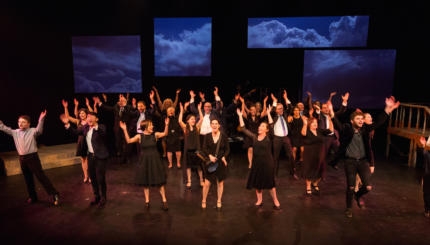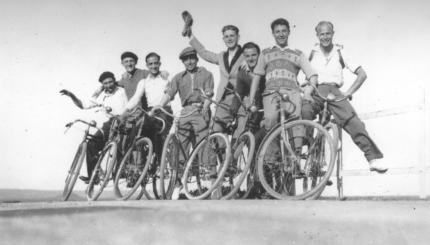Images reprinted with permission from the Ardon Estate.
Mordecai Ardon’s painting Sarah (1947) depicts the biblical matriarch in a blazing red dress, amidst a sea of blue-purple cloudy forms. Sarah’s arms reach for her face, but they more closely resemble animals’ claws readying themselves to tear her face apart. The anguish is appropriate. Sarah is standing over her son Isaac, who is bound and ready for slaughter.

Richard McBee has suggested that Ardon’s Sarah “is an early Israeli reaction to the Holocaust that harnesses the biblical metaphor of the tragic outcome of the story of the Binding of Isaac (The Jewish Press, June 6, 2006).” McBee cites a rabbinic text which, altering the Bible’s account, tells of Abraham actually sacrificing his son, a perfect fit for Ardon’s reference to the Holocaust. “The shock kills Sarah, just as the horrible reality of the millions slain in the extinguished the faith of untold thousands.”

Help us keep Jewish knowledge accessible to millions of people around the world.
Your donation to My Jewish Learning fuels endless journeys of Jewish discovery. With your help, My Jewish Learning can continue to provide nonstop opportunities for learning, connection and growth.
Ardon (1896-1992) has been called “Israel’s greatest painter,” and whether this is true (Israel has produced many phenomenal artists, including E. M. Lilien and Hermann Struck), he mixed a modern mode of paint application (bold and heavy) with a love of the European Old Masters, such as da Vinci and Rembrandt. This aesthetic marriage of the old and the new resonated in post-Holocaust Palestine.
Racing Against Time
Ardon, born Mordecai Eliezer Bronstein in Tuchow, Poland, was not supposed to be an artist but a watchmaker like his father. His first experience with art came when he observed a Jewish painter named Roth (his last name is lost) painting a lion, tiger, deer, and eagle in his synagogue. (The animals are Jewish symbols for ideal attributes of the diligent worshiper’s efforts to rise in the morning for prayer: for example, the lion’s strength and the deer’s speed.) Seeing the young Ardon copying his forms on a pad of paper, Roth descended his ladder and admired the drawings so much he pressured Ardon’s father to enroll the young boy in an art class.
This was not the last of the pressure that Ardon’s father endured. When Ardon showed promise in his studies, his teacher lobbied his father to send the young man to a local monastery to study Greek and Latin. Ardon’s observant father–who enjoyed regaling his son with tales–reluctantly agreed, but he insisted that Ardon receive a formal Jewish education of and Talmud, as well.
As a young child, Ardon created paper soldier cutouts, which one writer speculates were perhaps “made to protect him … against all of the demons and witches that people Jewish folklore.” Ardon developed a certain reputation for this sensitivity to mythology, and his eleven siblings called him sterngucker or stargazer.
Perhaps because the stars are always brighter in the neighboring village, Ardon ran away from home at age thirteen and a half to the nearby village of Tarnow, where he believed he would find a chance to become an artist.
From Socialism to the Bauhaus to Palestine
Eventually Ardon befriended members of the socialist party, and he amused his new friends by reciting Sholem Aleichem’s Tevye the Milkman in Yiddish. Upon the suggestion of an actor who complimented his delivery, Ardon later moved to Berlin, where he began acting, playing several roles, including Shylock, in Shakespeare’s Merchant of Venice.
In Berlin, Ardon met professors from the Weimar-based Bauhaus school, an avant-garde establishment featuring artists like Anni and Joseph Albers, Paul Klee, and Wassily Kandinsky.
To gain entry to the school, Ardon showed his drawing Steeple at Midnight, which depicts a church (an open door reveals a crucifixion), with a crow perched on the steeple. The drawing employs several Kabbalistic symbols, from a rooster to the staircases that personify time–all exploring the notion of tikkun chatzot, the idea that God converses with the righteous at midnight.
Ardon remained at the Bauhaus until it relocated in 1924, one year after he married his wife Miriam. From Weimar, the Ardons traveled back to Berlin, and escaped to Palestine in 1933, though Ardon would have preferred Paris. He wrote, “shipwrecked, I landed in Jerusalem.”
Jerusalem’s Gray Becomes a Colorful Spark
When he first arrived in Palestine at Kibbutz Kiryat Anavim, Ardon complained he was “unable to see color–everything was gray.”
But the grayness did not last long. “For Ardon the streets of Jerusalem evoked memories of childhood,” wrote Michele Vishny in Mordecai Ardon (Abrams, 1973). “In the Orthodox Jew who lived in the Mea Shearim district he saw himself as a boy, with his little hat, caftan, and side curls. It was the landscape, however, which engraved itself upon his mind and heart. As he walked through Jerusalem’s hills he felt a mystical attachment to the earth.”
Ardon joined the faculty of the Bezalel Academy, Israel’s renowned art school, in 1935 and became director five years later. From 1952 to 1963, he served as artistic advisor to Israel’s Ministry of Education and Culture.
More significantly, Ardon began contemplating the nature of the Jewish artist. In his 1949 essay “The Artist and the Earth,” Ardon reflected, “It will happen that the Jewish artist, at first, will go out naively beyond the wall of ancient Jerusalem… And suddenly the view of the Kidron Valley will be revealed to his eyes–revealed in all its primal state. And sometimes the artist will stand overwhelmed, almost afraid, will stand as though petrified … A first meeting takes place between the two [the artist and the earth]–and it is primal.”
But Does This Make A Jewish Artist?
Ardon said he always wondered why Eden had only two trees (the Tree of Knowledge and the Tree of Life). “I think there was a third one between the two,” he wrote. “It was the ‘Tree of the Secret,’ perhaps the ‘Tree of Mystery’ … The standpoint of the artist is between knowledge and life.”
 This mystery arose in Ardon’s work as light and colors, which he held to be synonymous. He was influenced by Rembrandt’s “hidden light,” which he related to the mystical light of Jerusalem. The Gates of Light (1953), a green painting clearly inspired by Bauhaus painter Paul Klee, contains Kabbalistic forms of sefirot. Ardon included several birds derived from the medieval Bird’s Head Haggadah. Kabbalistic symbolism also surface in The Story of a Candle (1954), and perhaps in other works like Eve (1963), Stones of the Ancient Wall (1962, one stone resembles a hamsa) and Sinai (1967), which features the biblical Golden Calf and Bronze Serpent).
This mystery arose in Ardon’s work as light and colors, which he held to be synonymous. He was influenced by Rembrandt’s “hidden light,” which he related to the mystical light of Jerusalem. The Gates of Light (1953), a green painting clearly inspired by Bauhaus painter Paul Klee, contains Kabbalistic forms of sefirot. Ardon included several birds derived from the medieval Bird’s Head Haggadah. Kabbalistic symbolism also surface in The Story of a Candle (1954), and perhaps in other works like Eve (1963), Stones of the Ancient Wall (1962, one stone resembles a hamsa) and Sinai (1967), which features the biblical Golden Calf and Bronze Serpent).
Indeed, at first glance, much of Ardon’s art seems outwardly mystical. But in response to an email, Ora Ardon, the widow of Mordecai’s only son, Michael, warned about ascribing too much religiosity to her father-in-law’s work. “Ardon was an Atheist and declared his Atheism publicly many times,” she wrote. “He painted several paintings based on Kabbala subjects, because he liked their poetic contents and the graphical drawings of the sefirot (God’s mystical attributes). But he did not like mysticism. In spite of his protests, he was, and is, often described as a Jewish mystic. Please do not make this mistake.”
Of Ardon’s other Jewish-themed work, Missa Dura (1958-1960), which means “hard mass,” might be his most important. The triptych–painting in three parts, often used in Christian art to juxtapose patrons and saints–references the Holocaust in one panel, titled “Kristallnacht.” Although the panel more literally includes spaghetti-like strings and bowling pins, the forms seem smashed, like the shards of glass from storefront windows destroyed during Kristallnacht. In the bottom right corner, the top rung of a ladder creeps into the painting, representing the ladder of Jacob’s dream, in which administrating angels ascended and descended. The first panel, “The Knight,” refers to Hitler, who fancied himself a knight of the Reich.
It is hard to question Ora Ardon’s claim that her father-in-law should not be considered a mystical or religious artist. But it is also hard to deny the importance of Ardon’s use of symbolism and mysticism in his work. Many Jewish artists before Ardon depicted the Holocaust or explored Kabbala, and doubtless many will continue to do so. But where many artists tried to use their art to solve questions of evil and mysticism, Ardon brought the Bauhaus school’s matter-of-fact approach to his works. He may not have sought to be a Jewish artist, but just by grappling with such difficult, complicated topics, he shed light on new aspects of Jewish and Israeli experiences and texts.


